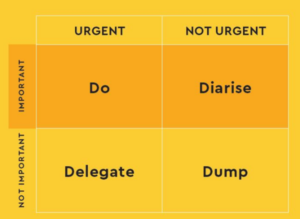Ever overheard the banter in the tearoom? It often goes like this:
-
-
- I need more time in my day.
- Can someone stop the world so I can catch up?
- I hadn’t finished yesterday’s tasks when I got 30 more.
- I’ve done nothing all day.
- I’m always putting out fires I didn’t cause.
What if I told you there’s a way to address ALL of these? And no, it doesn’t involve making your boss or that auditor disappear.
Enter the Eisenhower Matrix, a tool first invented by President Eisenhower to manage his demanding workload. Over 30 years later, Stephen Covey popularized it in The Seven Habits of Highly Effective People. With such a legacy, it’s clear this tool stands the test of time.
Below is a cheat sheet that offers a simple formula to manage every task on your plate. But first, let’s explore how you can put some Eisenhower magic to work for you.

Learning to triage
Ever been to an emergency room and been greeted by a triage nurse with a bunch of questions? If you show up with paralysis, difficulty speaking, and trouble walking, you’ll get a red tag and immediate care – before the stroke causes lasting damage.
A serious issue but not life-threatening? That’s an orange tag, meaning you’ll be seen soon, but after the reds. And your broken toe? You’ll get a green tag and likely wait alllll day.
Eisenhower’s Matrix works similarly, helping you triage tasks and create a clear priority playbook.
-
-
- Quadrant 1 (Important & Urgent): These are critical tasks, like handling a participant or client emergency – your “red tag” moments.
- Quadrant 3 (Urgent but Not Important): Tasks you should delegate, like handling low-priority interruptions.
- Quadrant 4 (Not Important & Not Urgent): Time-wasters, like reading irrelevant emails.
- Quadrant 2 (Important but Not Urgent): This is where real progress happens, and where most of your time should go. For example, after managing a crisis, Q2 is holding a debrief with your team or reviewing protocols to prevent future issues.
-
-
-
As a manger, CEO or business owner, as you go further up the organisational chart, your focus should be increasingly in Q2 – almost definitely more than it currently is.
The Important Quadrant
Prioritising tasks can often feel like herding cats. The key is understanding what’s truly important versus what’s simply urgent. To determine importance, ask yourself: Does this task align with my strategic objectives – like values, vision, mission, business plan, SWOT analysis, KPIs, or Code of Conduct?
Anything that moves the business forward and keeps it from getting bogged down in ‘busy work’ will always be important.
Sticking with our health metaphor, these are the tasks that prevent Quadrant 1 (urgent and important) crises from ever appearing.
Why not give our magic trick a try? You might just find your stresses disappear in a puff of smoke.
Curious about how to identify the specific quadrant two tasks that will make your team more productive and less stressed? Let’s do an audit.
Subscribe To Stay In Touch
From time to time I send out morsels that help you work smarter, not harder; hints and tips, research and statistics from the masters who study this stuff or early bird specials on upcoming courses.
Come on a 'no spam' journey with me.
You can always change your mind later.


0 Comments